工具系列:PyCaret介绍_二分类模型
👋 工具系列:PyCaret介绍_二分类模型
PyCaret是一个开源的、低代码的Python机器学习库,可以自动化机器学习工作流程。它是一个端到端的机器学习和模型管理工具,可以大大加快实验周期并提高工作效率。
与其他开源机器学习库相比,PyCaret是一个替代低代码库,可以用几行代码代替数百行代码。这使得实验速度指数级增加,效率更高。PyCaret本质上是围绕几个机器学习库和框架(如scikit-learn、XGBoost、LightGBM、CatBoost、spaCy、Optuna、Hyperopt、Ray等)的Python封装。
PyCaret的设计和简洁性受到了Gartner首次使用的公民数据科学家这一新兴角色的启发。公民数据科学家是能够执行简单和中等复杂的分析任务的高级用户,而以前这些任务需要更多的技术专业知识。
💻 安装
PyCaret在以下64位系统上进行了测试和支持:
- Python 3.7 - 3.10
- 仅适用于Ubuntu的Python 3.9
- Ubuntu 16.04或更高版本
- Windows 7或更高版本
您可以使用Python的pip软件包管理器安装PyCaret:
pip install pycaret
PyCaret的默认安装不会自动安装所有额外的依赖项。为此,您需要安装完整版本:
pip install pycaret[full]
或者根据您的用例,您可以安装以下其中之一的变体:
pip install pycaret[analysis]pip install pycaret[models]pip install pycaret[tuner]pip install pycaret[mlops]pip install pycaret[parallel]pip install pycaret[test]
# 导入pycaret库
import pycaret
# 打印pycaret库的版本号
pycaret.__version__
'3.0.0'
🚀 快速开始
PyCaret的分类模块是一个监督学习模块,用于将元素分类到不同的组中。其目标是预测离散且无序的分类标签。
一些常见的用例包括预测客户是否违约(是或否)、预测客户流失(客户将离开或保留)、发现的疾病(阳性或阴性)。
该模块可用于二分类或多分类问题。它提供了几种预处理功能,通过设置函数对数据进行建模准备。它拥有超过18种可直接使用的算法和多个图表,用于分析训练模型的性能。
在PyCaret中,典型的工作流程按照以下5个步骤进行:
设置 ?? 比较模型 ?? 分析模型 ?? 预测 ?? 保存模型
# 从pycaret数据集模块加载示例数据集
from pycaret.datasets import get_data
data = get_data('diabetes')

设置
此函数初始化训练环境并创建转换流水线。在执行PyCaret中的任何其他函数之前,必须调用设置函数。它只有两个必需的参数,即data和target。所有其他参数都是可选的。
# 导入pycaret分类模块和初始化设置
from pycaret.classification import *
# 初始化设置
# data: 数据集,包含特征和目标变量
# target: 目标变量的名称
# session_id: 设置随机种子,用于复现结果
s = setup(data, target='Class variable', session_id=123)
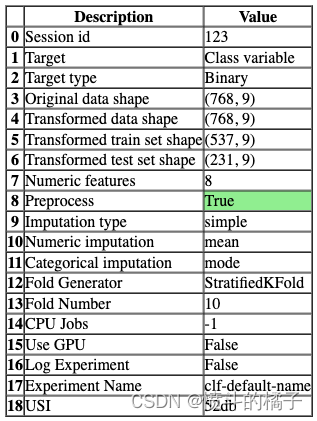
一旦设置成功执行,它将显示包含实验级别信息的信息网格。
- 会话ID: 伪随机数,在所有函数中作为种子分布,以便以后可以重现。如果没有传递
session_id,则会自动生成一个随机数,并分发给所有函数。
- 目标类型: 二进制、多类或回归。目标类型会自动检测。
- 标签编码: 当目标变量为字符串类型(例如’Yes’或’No’)而不是1或0时,它会自动将标签编码为1和0,并显示映射(0:No,1:Yes)以供参考。在本教程中,不需要进行标签编码,因为目标变量是数值类型。
- 原始数据形状: 在进行任何转换之前的原始数据形状。
- 转换后的训练集形状: 转换后的训练集形状
- 转换后的测试集形状: 转换后的测试集形状
- 数值特征: 被视为数值的特征数量。
- 分类特征: 被视为分类的特征数量。
PyCaret中有两组API供您使用。 (1) 函数式API(如上所示)和 (2) 面向对象的API。
使用面向对象的API时,您不会直接执行函数,而是导入一个类并执行类的方法。
# 导入ClassificationExperiment类并初始化该类
from pycaret.classification import ClassificationExperiment
exp = ClassificationExperiment()
# 检查exp的类型
type(exp)
pycaret.classification.oop.ClassificationExperiment
# 初始化设置实验
exp.setup(data, target='Class variable', session_id=123)
# 参数说明:
# - data: 数据集,用于训练和测试模型
# - target: 目标变量,即我们要预测的变量
# - session_id: 实验的会话ID,用于复现实验结果
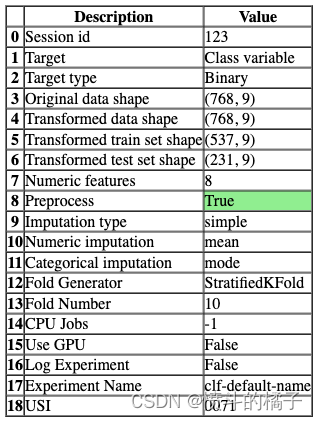
<pycaret.classification.oop.ClassificationExperiment at 0x2e24286edc0>
你可以使用任何一种方法,即函数式或面向对象编程,并且可以在两组API之间来回切换。选择的方法不会影响结果,并且已经进行了一致性测试。
比较模型
该函数使用交叉验证训练和评估模型库中所有可用的估计器的性能。该函数的输出是一个带有平均交叉验证分数的评分表。可以使用get_metrics函数访问CV期间评估的指标。可以使用add_metric和remove_metric函数添加或删除自定义指标。
# 比较基准模型
# 使用compare_models()函数比较不同的基准模型,该函数会自动选择最佳的模型
best = compare_models()

Processing: 0%| | 0/69 [00:00<?, ?it/s]
# 比较模型
exp.compare_models()
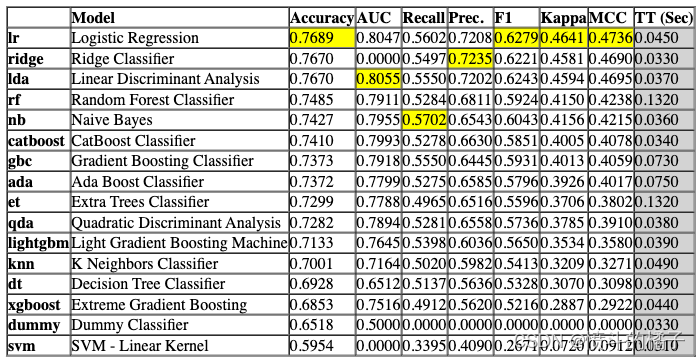
Processing: 0%| | 0/69 [00:00<?, ?it/s]

注意,函数式API和面向对象API之间的输出是一致的。本笔记本中的其余函数将仅使用函数式API显示。
分析模型
您可以使用plot_model函数来分析训练模型在测试集上的性能。在某些情况下,可能需要重新训练模型。
# 绘制混淆矩阵
# best是训练好的模型
# plot_model是一个函数,用于绘制模型的混淆矩阵
# 'confusion_matrix'是绘制混淆矩阵的参数
# 返回一个混淆矩阵图像
plot_model(best, plot='confusion_matrix')
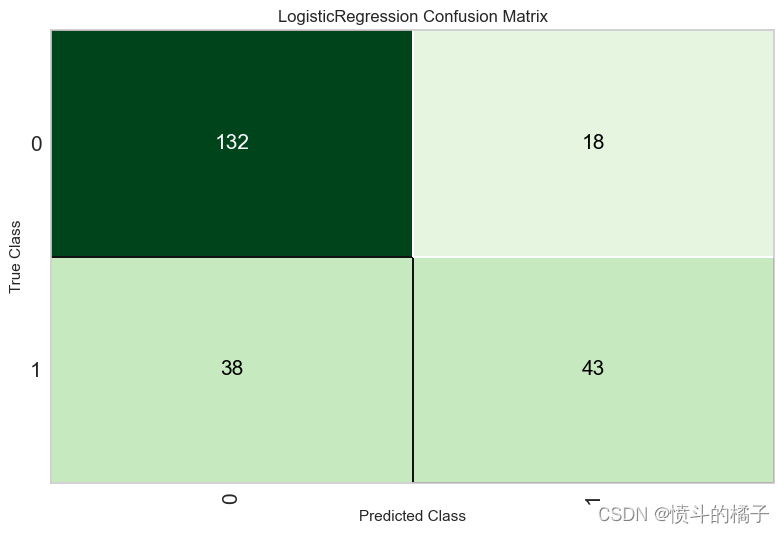
# 绘制模型的AUC曲线
# 参数best表示要绘制AUC曲线的模型
# 参数plot='auc'表示绘制AUC曲线
plot_model(best, plot='auc')

# 绘制特征重要性图
plot_model(model, plot='feature')
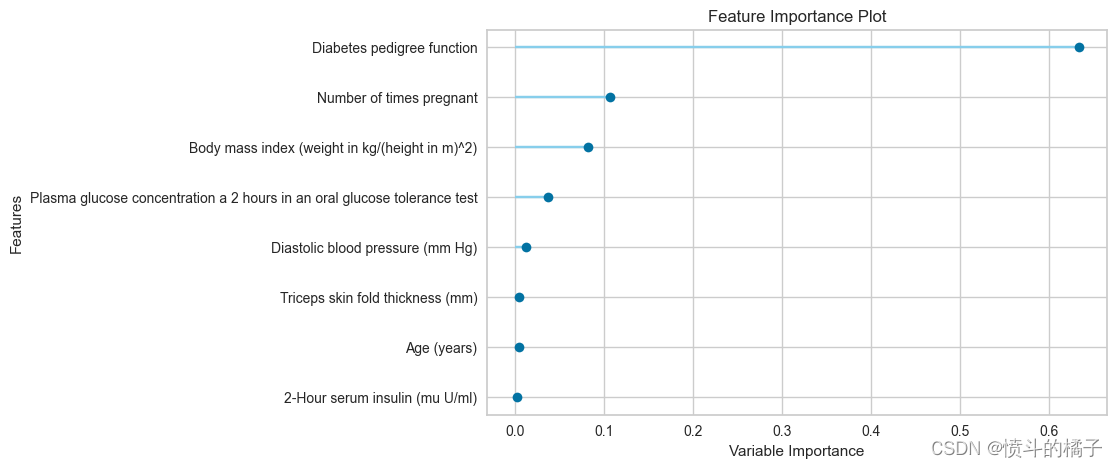
# 查询可使用的绘图功能
# help(plot_model)
An alternate to plot_model function is evaluate_model. It can only be used in Notebook since it uses ipywidget.
evaluate_model(best)
interactive(children=(ToggleButtons(description='Plot Type:', icons=('',), options=(('Pipeline Plot', 'pipelin…
预测
predict_model 函数会在数据框中返回 prediction_label 和 prediction_score(预测类别的概率)作为新的列。当数据为 None(默认值)时,它会使用在设置函数期间创建的测试集进行评分。
# 预测测试集数据
# 使用之前训练好的模型对测试集数据进行预测
holdout_pred = predict_model(best)

# 展示预测结果的数据框
# 使用head()函数显示数据框的前几行,默认显示前5行
holdout_pred.head()

相同的函数适用于预测未见过的数据集上的标签。让我们创建原始数据的副本并删除Class variable。然后,我们可以使用没有标签的新数据框进行评分。
# 复制data,删除Class variable列
new_data = data.copy()
new_data.drop('Class variable', axis=1, inplace=True)
new_data.head()

# 在新数据上预测模型
predictions = predict_model(best, data = new_data)
predictions.head()

保存模型
最终我们可以使用save_model保存整个流水线
# save pipeline
save_model(best, 'my_first_pipeline')
Transformation Pipeline and Model Successfully Saved
(Pipeline(memory=FastMemory(location=C:\Users\owner\AppData\Local\Temp\joblib),
steps=[('clean_column_names',
TransformerWrapper(exclude=None, include=None,
transformer=CleanColumnNames(match='[\\]\\[\\,\\{\\}\\"\\:]+'))),
('numerical_imputer',
TransformerWrapper(exclude=None,
include=['Number of times pregnant',
'Plasma glucose concentration a 2 '
'hours in an oral glu...
fill_value=None,
missing_values=nan,
strategy='most_frequent',
verbose='deprecated'))),
('trained_model',
LogisticRegression(C=1.0, class_weight=None, dual=False,
fit_intercept=True, intercept_scaling=1,
l1_ratio=None, max_iter=1000,
multi_class='auto', n_jobs=None,
penalty='l2', random_state=123,
solver='lbfgs', tol=0.0001, verbose=0,
warm_start=False))],
verbose=False),
'my_first_pipeline.pkl')
# 读取模型
loaded_best_pipeline = load_model('my_first_pipeline')
loaded_best_pipeline
Transformation Pipeline and Model Successfully Loaded
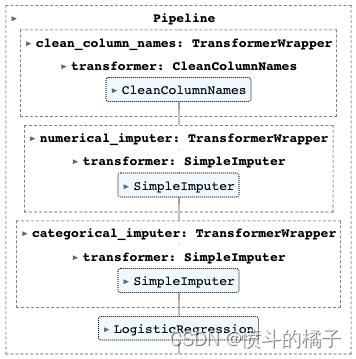
👇 详细的逐个函数概述
? 设置
setup 函数在 PyCaret 中初始化实验,并根据传入函数的所有参数创建转换流水线。在执行任何其他函数之前,必须调用 setup 函数。它有两个必需的参数:data 和 target。所有其他参数都是可选的,用于配置数据预处理流水线。
# 使用setup函数对数据进行预处理和设置
# 参数data表示要处理的数据
# 参数target表示目标变量的名称,即要预测的变量
# 参数session_id表示设置的会话ID,用于重现结果
s = setup(data, target = 'Class variable', session_id = 123)
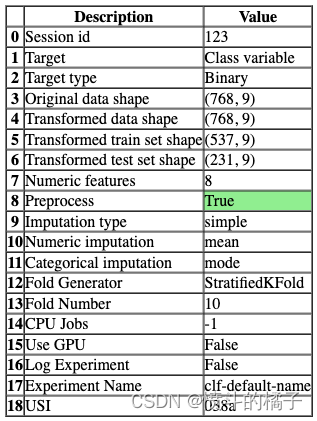
要访问由设置函数创建的所有变量,例如转换后的数据集、随机状态等,您可以使用get_config方法。
# 获取所有可用的配置信息
get_config()
{'USI',
'X',
'X_test',
'X_test_transformed',
'X_train',
'X_train_transformed',
'X_transformed',
'_available_plots',
'_ml_usecase',
'data',
'dataset',
'dataset_transformed',
'exp_id',
'exp_name_log',
'fix_imbalance',
'fold_generator',
'fold_groups_param',
'fold_shuffle_param',
'gpu_n_jobs_param',
'gpu_param',
'html_param',
'idx',
'is_multiclass',
'log_plots_param',
'logging_param',
'memory',
'n_jobs_param',
'pipeline',
'seed',
'target_param',
'test',
'test_transformed',
'train',
'train_transformed',
'variable_and_property_keys',
'variables',
'y',
'y_test',
'y_test_transformed',
'y_train',
'y_train_transformed',
'y_transformed'}
# 获取配置文件中的X_train_transformed数据
get_config('X_train_transformed')

# 打印当前的种子值
print("当前的种子值为: {}".format(get_config('seed')))
# 使用set_config函数来改变种子值
set_config('seed', 786)
# 打印新的种子值
print("新的种子值为: {}".format(get_config('seed')))
The current seed is: 123
The new seed is: 786
预处理配置和实验设置/参数都传递给setup函数。要查看所有可用参数,请检查docstring:
# help(setup)
# 初始化设置,使用normalize = True
s = setup(data, target = 'Class variable', session_id = 123,
normalize = True, normalize_method = 'minmax')
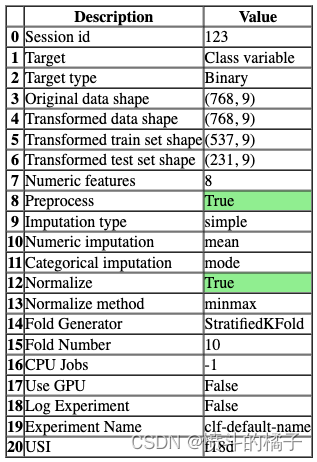
# 获取X_train_transformed的配置信息
get_config('X_train_transformed')['Number of times pregnant'].hist()
<AxesSubplot:>
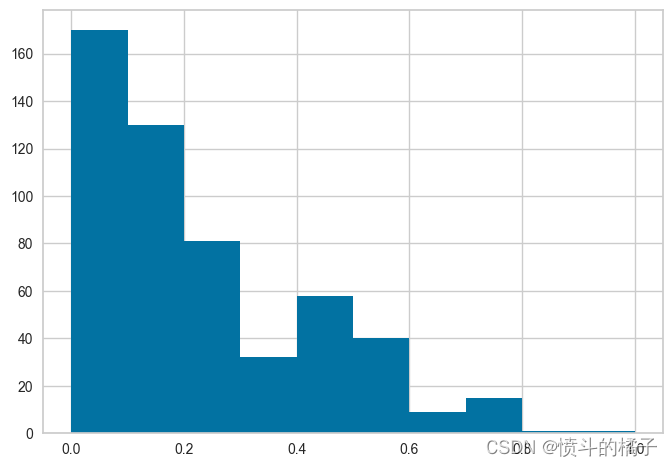
注意,所有的值都在0和1之间 - 这是因为我们在setup函数中传递了normalize=True。如果你不记得它与实际数据的比较方式,没问题 - 我们也可以使用get_config来访问非转换的值,然后进行比较。请参见下面的内容,并注意x轴上的值范围,并将其与上面的直方图进行比较。
# 获取配置文件中的训练数据集X_train的年龄列
get_config('X_train')['Number of times pregnant'].hist()
<AxesSubplot:>
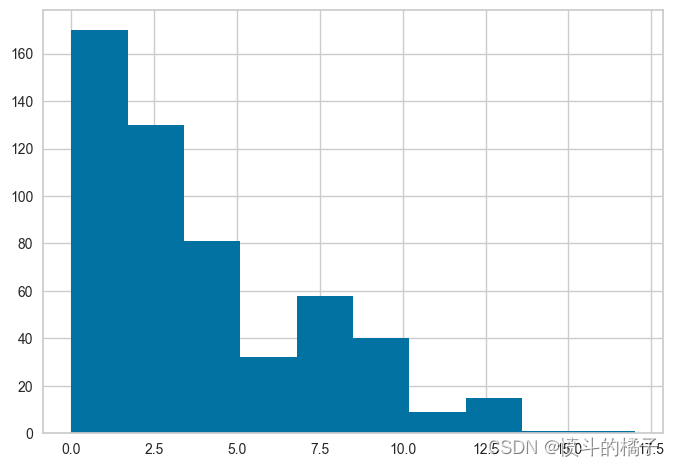
? 比较模型
compare_models 函数使用交叉验证训练和评估模型库中所有可用的估计器的性能。该函数的输出是一个带有平均交叉验证分数的评分网格。可以使用 get_metrics 函数访问 CV 期间评估的指标。可以使用 add_metric 和 remove_metric 函数添加或删除自定义指标。
best = compare_models()
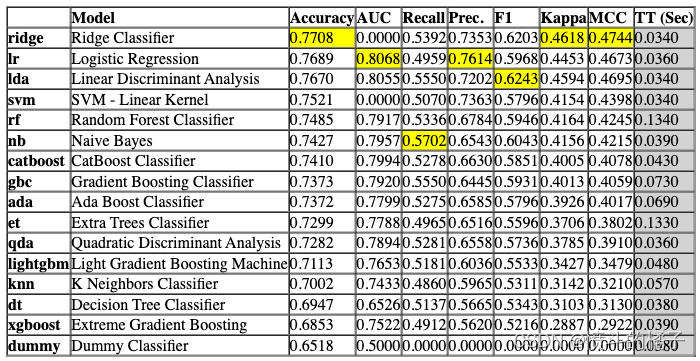
Processing: 0%| | 0/69 [00:00<?, ?it/s]
compare_models默认使用模型库中的所有估计器(除了Turbo=False的模型)。要查看所有可用的模型,您可以使用函数models()。
# 调用函数来检查可用的模型
models()

您可以在compare_models中使用include和exclude参数,只训练选择的模型或通过在exclude参数中传递模型id来排除特定模型的训练。
# 使用compare_models函数比较不同的决策树模型
compare_tree_models = compare_models(include = ['dt', 'rf', 'et', 'gbc', 'xgboost', 'lightgbm', 'catboost'])

Processing: 0%| | 0/33 [00:00<?, ?it/s]
compare_tree_models

功能上面的函数返回训练好的模型对象作为输出。评分网格只显示,不返回。如果您需要访问评分网格,可以使用pull函数访问数据框。
compare_tree_models_results = pull()
compare_tree_models_results

默认情况下,compare_models函数返回基于sort参数中定义的指标的最佳性能模型。让我们修改我们的代码,返回基于MAE的前3个最佳模型。
# 导入所需的库
from pycaret.classification import compare_models
# 使用compare_models函数来比较不同模型的性能
# sort参数设置为'Recall',表示按照召回率对模型进行排序
# n_select参数设置为3,表示选择排名前3的模型
best_recall_models_top3 = compare_models(sort='Recall', n_select=3)

Processing: 0%| | 0/71 [00:00<?, ?it/s]
# 定义一个列表,用于存储Recall最高的前三个模型的名称
best_recall_models_top3
[GaussianNB(priors=None, var_smoothing=1e-09),
GradientBoostingClassifier(ccp_alpha=0.0, criterion='friedman_mse', init=None,
learning_rate=0.1, loss='log_loss', max_depth=3,
max_features=None, max_leaf_nodes=None,
min_impurity_decrease=0.0, min_samples_leaf=1,
min_samples_split=2, min_weight_fraction_leaf=0.0,
n_estimators=100, n_iter_no_change=None,
random_state=123, subsample=1.0, tol=0.0001,
validation_fraction=0.1, verbose=0,
warm_start=False),
LinearDiscriminantAnalysis(covariance_estimator=None, n_components=None,
priors=None, shrinkage=None, solver='svd',
store_covariance=False, tol=0.0001)]
一些在compare_models中可能非常有用的其他参数有:
- fold
- cross_validation
- budget_time
- errors
- probability_threshold
- parallel
您可以查看函数的文档字符串以获取更多信息。
# help(compare_models)
? 设置自定义指标
# 定义一个函数get_metrics,用于获取可用的CV(交叉验证)指标
get_metrics()

# 导入numpy库
import numpy as np
def custom_metric(y, y_pred):
tp = np.where((y_pred==1) & (y==1), (100), 0)
fp = np.where((y_pred==1) & (y==0), -5, 0)
return np.sum([tp,fp])
# 将自定义指标添加到PyCaret中,指标名称为'custom_metric',显示名称为'Custom Metric',计算方法为custom_metric函数
add_metric('custom_metric', 'Custom Metric', custom_metric)
Name Custom Metric
Display Name Custom Metric
Score Function <function custom_metric at 0x000002E24B0EA430>
Scorer make_scorer(custom_metric)
Target pred
Args {}
Greater is Better True
Multiclass True
Custom True
Name: custom_metric, dtype: object
# 现在让我们再次运行compare_models函数
compare_models() # 调用compare_models函数,用于比较不同模型的性能
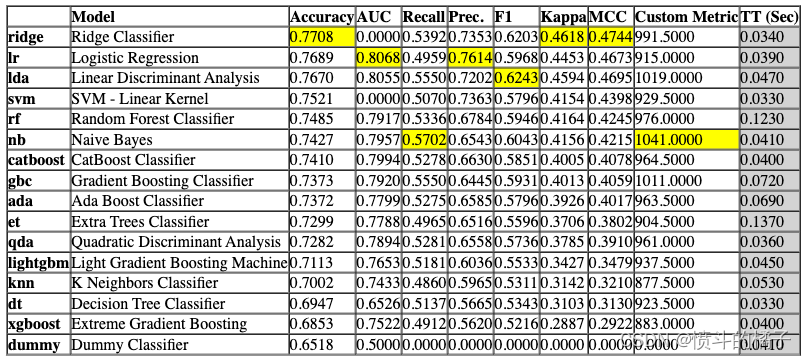
Processing: 0%| | 0/69 [00:00<?, ?it/s]

# 移除自定义指标
remove_metric('custom_metric')
? 实验日志记录
PyCaret与许多不同类型的实验记录器集成(默认为’mlflow’)。要在PyCaret中启用实验跟踪,您可以设置log_experiment和experiment_name参数。它将根据定义的记录器自动跟踪所有指标、超参数和工件。
# 使用setup函数对数据进行预处理和建模
# data为数据集,target为目标变量的名称
# log_experiment参数设置为'mlflow',表示将实验日志记录到mlflow中
# experiment_name参数设置为'diabetes_experiment',表示实验的名称为diabetes_experiment
s = setup(data, target='Class variable', log_experiment='mlflow', experiment_name='diabetes_experiment')
# 比较模型
# best = compare_models()
# !mlflow ui
默认情况下,PyCaret使用MLFlow记录器,可以使用log_experiment参数进行更改。以下记录器可用:
- mlflow
- wandb
- comet_ml
- dagshub
您可能会发现有用的其他与日志记录相关的参数有:
- experiment_custom_tags
- log_plots
- log_data
- log_profile
有关更多信息,请查看setup函数的文档字符串。
# help(setup)
? 创建模型
该函数使用交叉验证训练和评估给定估计器的性能。该函数的输出是一个包含每折交叉验证得分的评分网格。可以使用get_metrics函数访问在交叉验证期间评估的指标。可以使用add_metric和remove_metric函数添加或删除自定义指标。可以使用models函数访问所有可用的模型。
# 查看所有可用的模型
models()
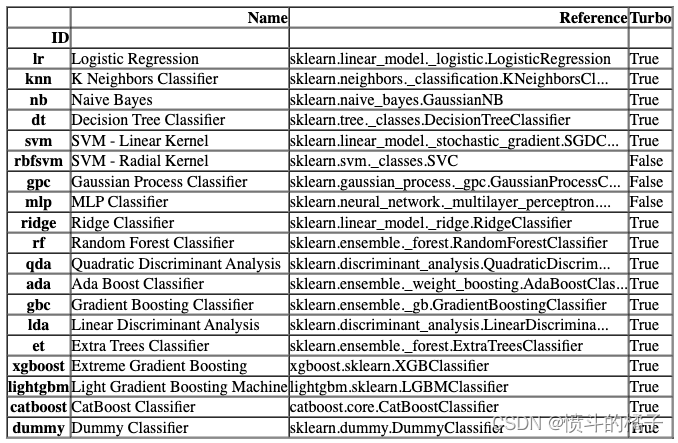
# 使用默认的折叠数(fold=10)来训练逻辑回归模型
lr = create_model('lr')
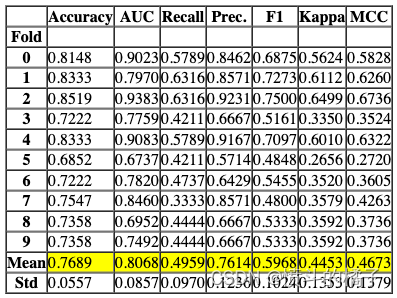
Processing: 0%| | 0/4 [00:00<?, ?it/s]
功能以上返回训练好的模型对象作为输出。评分表格仅显示而不返回。如果您需要访问评分表格,可以使用pull函数访问数据框。
# 从pull()函数中获取lr_results变量
lr_results = pull()
# 打印lr_results的数据类型
print(type(lr_results))
# 打印lr_results的值
<class 'pandas.core.frame.DataFrame'>
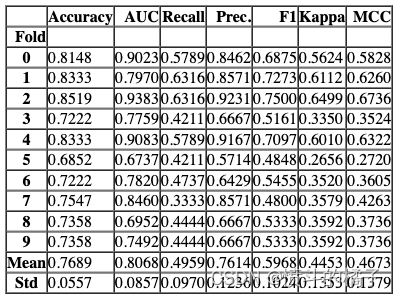
# 使用逻辑回归算法创建一个模型
# fold=3表示使用3折交叉验证
lr = create_model('lr', fold=3)
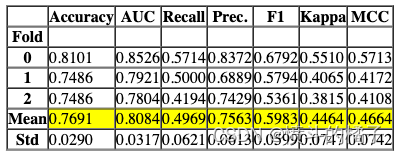
Processing: 0%| | 0/4 [00:00<?, ?it/s]
# 定义一个函数create_model,用于训练逻辑回归模型,并指定模型参数
create_model('lr', C = 0.5, l1_ratio = 0.15)
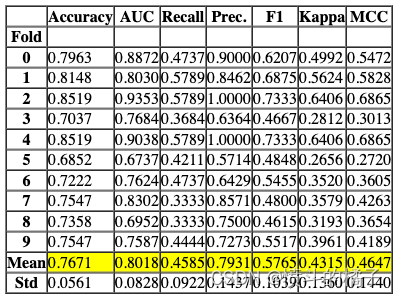
Processing: 0%| | 0/4 [00:00<?, ?it/s]

# 定义函数create_model,用于训练逻辑回归模型,并返回训练得分和交叉验证得分
create_model('lr', return_train_score=True)
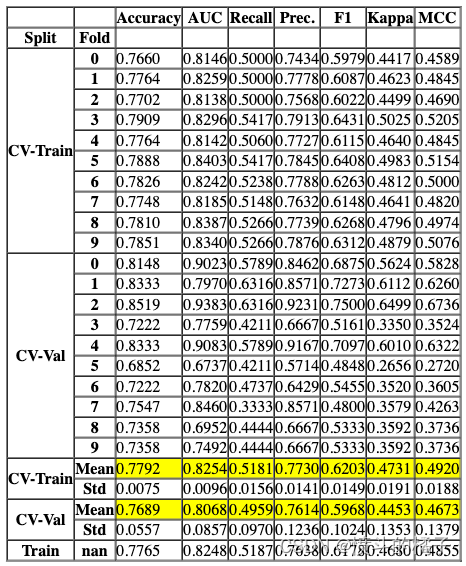
Processing: 0%| | 0/4 [00:00<?, ?it/s]

# 创建一个逻辑回归模型,并将分类器的概率阈值设置为0.66
create_model('lr', probability_threshold = 0.66)
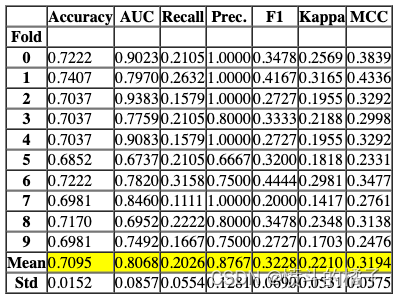
Processing: 0%| | 0/4 [00:00<?, ?it/s]

一些在create_model中可能非常有用的其他参数包括:
- cross_validation
- engine
- fit_kwargs
- groups
您可以查看函数的文档字符串以获取更多信息。
# help(create_model)
? 调整模型
该函数用于调整模型的超参数。该函数的输出是一个通过交叉验证得到的得分网格。根据优化参数中定义的指标选择最佳模型。可以使用get_metrics函数访问交叉验证期间评估的指标。可以使用add_metric和remove_metric函数添加或删除自定义指标。
# 使用默认参数创建一个决策树模型
dt = create_model('dt')
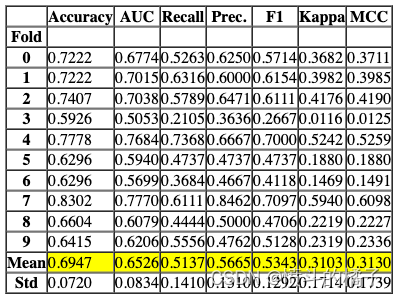
Processing: 0%| | 0/4 [00:00<?, ?it/s]
# 调整决策树模型的超参数
# 使用tune_model函数对决策树模型进行超参数调整,并将调整后的模型赋值给tuned_dt变量。
tuned_dt = tune_model(dt)
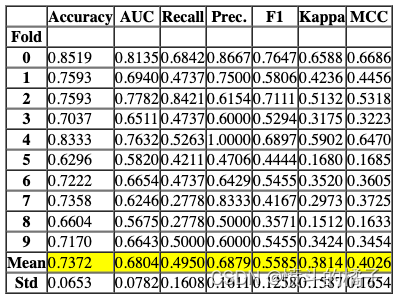
Processing: 0%| | 0/7 [00:00<?, ?it/s]
Fitting 10 folds for each of 10 candidates, totalling 100 fits
可以在 optimize 参数中定义要优化的度量标准(默认为 ‘Accuracy’)。此外,还可以使用 custom_grid 参数传递自定义调整的网格。
dt

# 定义调参网格
dt_grid = {'max_depth' : [None, 2, 4, 6, 8, 10, 12]}
# 使用自定义网格和评估指标为F1来调整模型
tuned_dt = tune_model(dt, custom_grid = dt_grid, optimize = 'F1')

Processing: 0%| | 0/7 [00:00<?, ?it/s]
Fitting 10 folds for each of 7 candidates, totalling 70 fits
# 使用tune_model函数对决策树模型进行调参,并返回调参后的模型和调参器对象
tuned_dt, tuner = tune_model(dt, return_tuner=True)
# 返回的tuned_dt是经过调参后的决策树模型
# 返回的tuner是用于调参的对象,可以通过该对象访问调参器的属性和方法
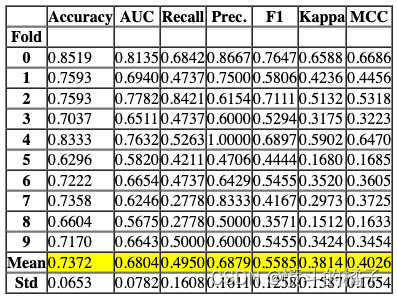
Processing: 0%| | 0/7 [00:00<?, ?it/s]
Fitting 10 folds for each of 10 candidates, totalling 100 fits
tuned_dt

# 创建一个调参器对象
# tuner object
tuner
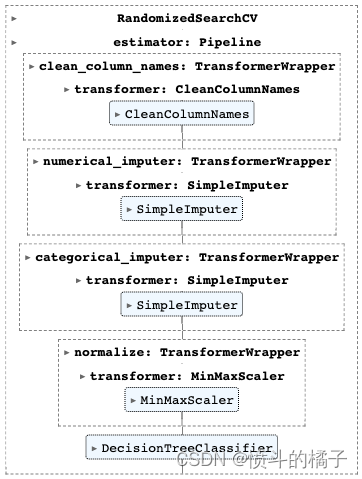
默认的搜索算法是sklearn中的RandomizedSearchCV。可以通过使用search_library和search_algorithm参数来进行更改。
# 使用 Optuna 调整决策树模型(dt)
# 调用 tune_model 函数,传入决策树模型(dt)和搜索库(optuna)
tuned_dt = tune_model(dt, search_library='optuna')

Processing: 0%| | 0/7 [00:00<?, ?it/s]
[32m[I 2023-02-16 14:23:58,902][0m Searching the best hyperparameters using 537 samples...[0m
[32m[I 2023-02-16 14:24:07,369][0m Finished hyperparemeter search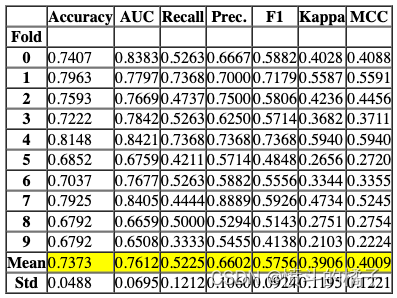
Processing: 0%| | 0/6 [00:00<?, ?it/s]

# 调用ensemble_model函数,传入参数dt和method
# dt是决策树模型
# method是指定的集成方法,这里是'Boosting',表示使用Boosting算法进行集成
ensemble_model(dt, method='Boosting')
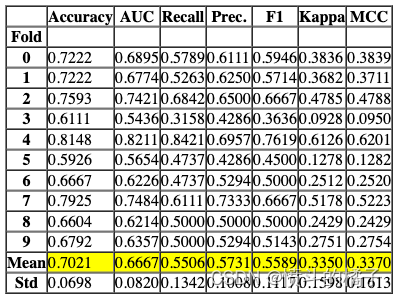
Processing: 0%| | 0/6 [00:00<?, ?it/s]

一些在ensemble_model中可能非常有用的其他参数有:
- choose_better
- n_estimators
- groups
- fit_kwargs
- probability_threshold
- return_train_score
您可以查看函数的文档字符串以获取更多信息。
# 导入ensemble_model模块
import ensemble_model
# 调用ensemble_model模块中的函数
ensemble_model.function()
? 混合模型
该函数用于训练一个软投票/多数规则分类器,该分类器选择在estimator_list参数中传递的模型。该函数的输出是一个包含交叉验证得分的评分网格。可以使用get_metrics函数访问在交叉验证期间评估的指标。可以使用add_metric和remove_metric函数添加或删除自定义指标。
# 定义一个变量best_recall_models_top3,用于存储基于召回率的前三个模型的信息
best_recall_models_top3
[GaussianNB(priors=None, var_smoothing=1e-09),
GradientBoostingClassifier(ccp_alpha=0.0, criterion='friedman_mse', init=None,
learning_rate=0.1, loss='log_loss', max_depth=3,
max_features=None, max_leaf_nodes=None,
min_impurity_decrease=0.0, min_samples_leaf=1,
min_samples_split=2, min_weight_fraction_leaf=0.0,
n_estimators=100, n_iter_no_change=None,
random_state=123, subsample=1.0, tol=0.0001,
validation_fraction=0.1, verbose=0,
warm_start=False),
LinearDiscriminantAnalysis(covariance_estimator=None, n_components=None,
priors=None, shrinkage=None, solver='svd',
store_covariance=False, tol=0.0001)]
# blend_models函数用于将最佳召回率的前三个模型进行融合
# 参数best_recall_models_top3是一个包含最佳召回率的前三个模型的列表
# 在这个函数中,我们将使用某种方法将这三个模型进行融合,以期望得到更好的结果
# 返回值是融合后的模型
blend_models(best_recall_models_top3)
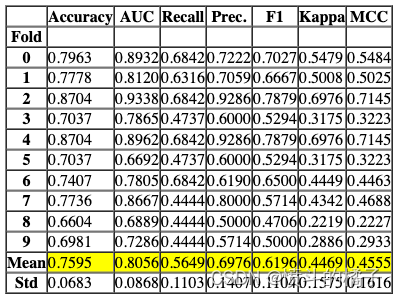
Processing: 0%| | 0/6 [00:00<?, ?it/s]

一些在blend_models中可能非常有用的其他参数包括:
- choose_better
- method
- weights
- fit_kwargs
- probability_threshold
- return_train_score
您可以查看函数的文档字符串以获取更多信息。
# help(blend_models)
? 堆叠模型
该函数在estimator_list参数中传递的选择估计器上训练一个元模型。该函数的输出是一个包含每个折叠的CV分数的评分网格。可以使用get_metrics函数访问CV期间评估的指标。可以使用add_metric和remove_metric函数添加或删除自定义指标。
# 将模型堆叠起来
# 参数:
# best_recall_models_top3: 一个包含了最佳召回率的前三个模型的列表
stack_models(best_recall_models_top3)
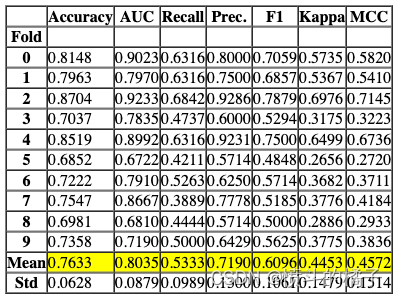
Processing: 0%| | 0/6 [00:00<?, ?it/s]

任务:请翻译以下markdown为中文,请保留markdown的格式,并输出翻译结果。
语料:
一些在stack_models中可能非常有用的其他参数包括:
- choose_better
- meta_model
- method
- restack
- probability_threshold
- return_train_score
您可以查看函数的文档字符串以获取更多信息。
# help(stack_models)
? 绘制模型
该函数用于分析训练好的模型在留置集上的性能。在某些情况下,可能需要重新训练模型。
# 调用函数绘制分类报告图表
plot_model(best, plot = 'class_report')
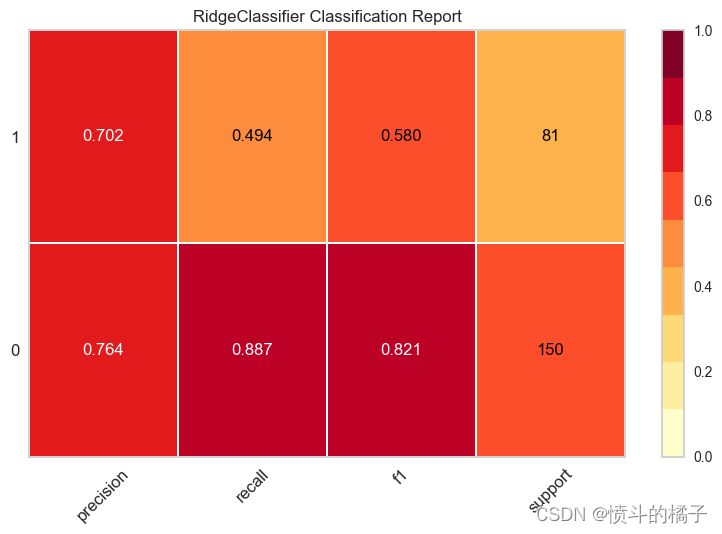
# 绘制模型评估报告的图表
# best: 最佳模型
# plot = 'class_report': 绘制分类报告
# scale = 2: 控制图表的缩放比例为2
plot_model(best, plot='class_report', scale=2)

# 保存分类报告的绘图
plot_model(best, plot = 'class_report', save=True)
'Class Report.png'
一些在plot_model中可能非常有用的其他参数包括:
- fit_kwargs
- plot_kwargs
- groups
- display_format
您可以查看函数的文档字符串以获取更多信息。
# help(plot_model)
? 解释模型
该函数分析训练模型生成的预测结果。该函数中的大多数图表是基于SHAP(Shapley Additive exPlanations)实现的。有关更多信息,请参见https://shap.readthedocs.io/en/latest/
# 使用'lightgbm'算法创建一个分类模型
lightgbm = create_model('lightgbm')
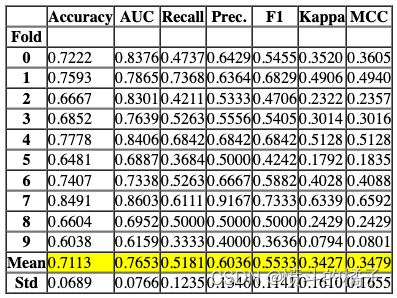
Processing: 0%| | 0/4 [00:00<?, ?it/s]
# 使用interpret_model函数对模型进行解释
# 参数lightgbm表示使用的模型为lightgbm模型
# 参数plot表示是否绘制模型的摘要图,默认为True
interpret_model(lightgbm, plot='summary')
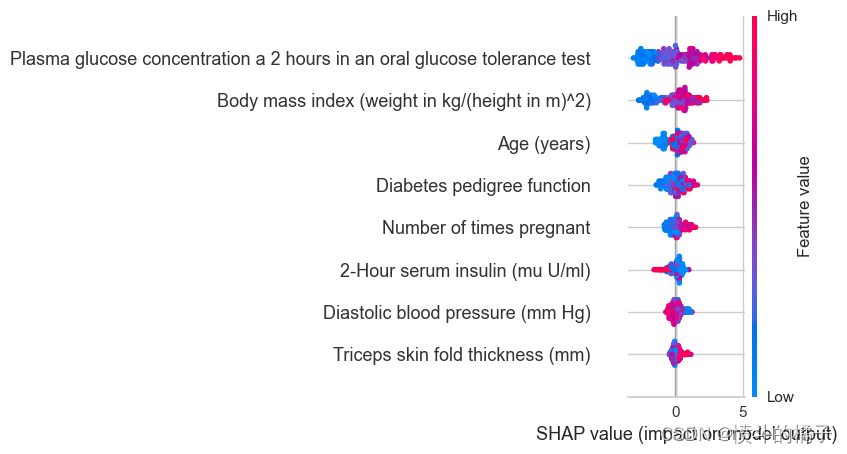
# 使用lightgbm模型解释测试集观察值1的原因图
interpret_model(lightgbm, plot='reason', observation=1)

一些在interpret_model中可能非常有用的其他参数有:
- plot
- feature
- use_train_data
- X_new_sample
- y_new_sample
- save
您可以查看函数的文档字符串以获取更多信息。
# help(interpret_model)
? 校准模型
该函数使用保序回归或逻辑回归来校准给定模型的概率。该函数的输出是一个带有交叉验证得分的评分网格。可以使用get_metrics函数访问CV期间评估的指标。可以使用add_metric和remove_metric函数添加或删除自定义指标。
# 绘制决策树的校准图
# 参数plot='calibration'表示绘制校准图
plot_model(dt, plot='calibration')
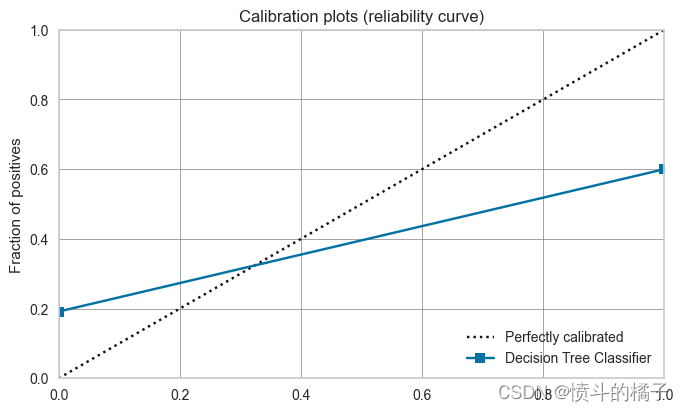
# 设置默认的时间间隔(dt)校准
calibrated_dt = calibrate_model(dt)
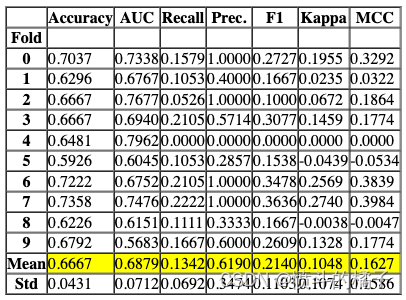
Processing: 0%| | 0/6 [00:00<?, ?it/s]
# 使用plot_model函数绘制校准后的决策树模型的校准曲线图
# 参数calibrated_dt表示校准后的决策树模型
# 参数plot='calibration'表示绘制校准曲线图
plot_model(calibrated_dt, plot='calibration')

一些在calibrate_model中可能非常有用的其他参数包括:
- calibrate_fold
- fit_kwargs
- method
- return_train_score
- groups
您可以查看函数的文档字符串以获取更多信息。
# help(calibrate_model)
? 获取排行榜
该函数返回当前设置中训练的所有模型的排行榜。
# 获取排行榜
lb = get_leaderboard()
Processing: 0%| | 0/76 [00:00<?, ?it/s]

# 根据F1值选择最佳模型
# 使用sort_values方法对数据框lb按照F1列进行降序排序
# 使用['Model']索引选择'Model'列
# 使用iloc[0]选择排序后的第一个模型作为最佳模型
lb.sort_values(by='F1', ascending=False)['Model'].iloc[0]
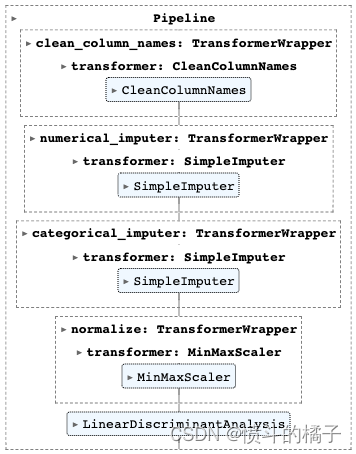
任务:请翻译以下markdown为中文,请保留markdown的格式,并输出翻译结果。
语料:
一些你可能会在get_leaderboard中发现非常有用的其他参数有:
- finalize_models
- fit_kwargs
- model_only
- groups
你可以查看函数的文档字符串以获取更多信息。
# help(get_leaderboard)
? AutoML
该函数根据优化参数返回当前设置中所有训练模型中的最佳模型。可以使用get_metrics函数访问评估的指标。
automl()

? 检查公平性
有许多方法可以概念化公平性。check_fairness函数遵循被称为群体公平性的方法,它询问:哪些个体群体有可能遭受伤害。check_fairness提供了不同群体(也称为子群体)之间的公平性相关指标。
# 检查公平性
# best: 模型的最佳参数
# sensitive_features: 敏感特征,用于评估模型的公平性
check_fairness(best, sensitive_features = ['Number of times pregnant'])

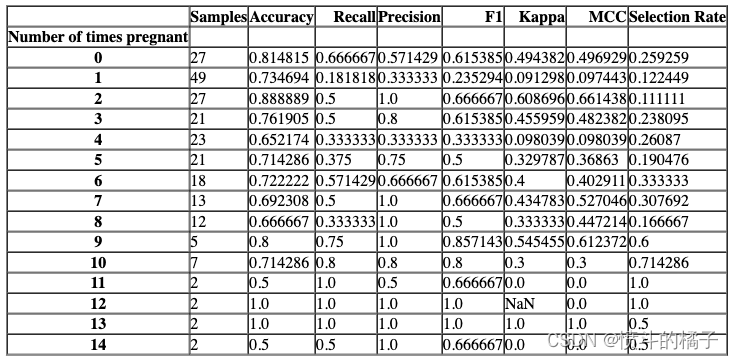
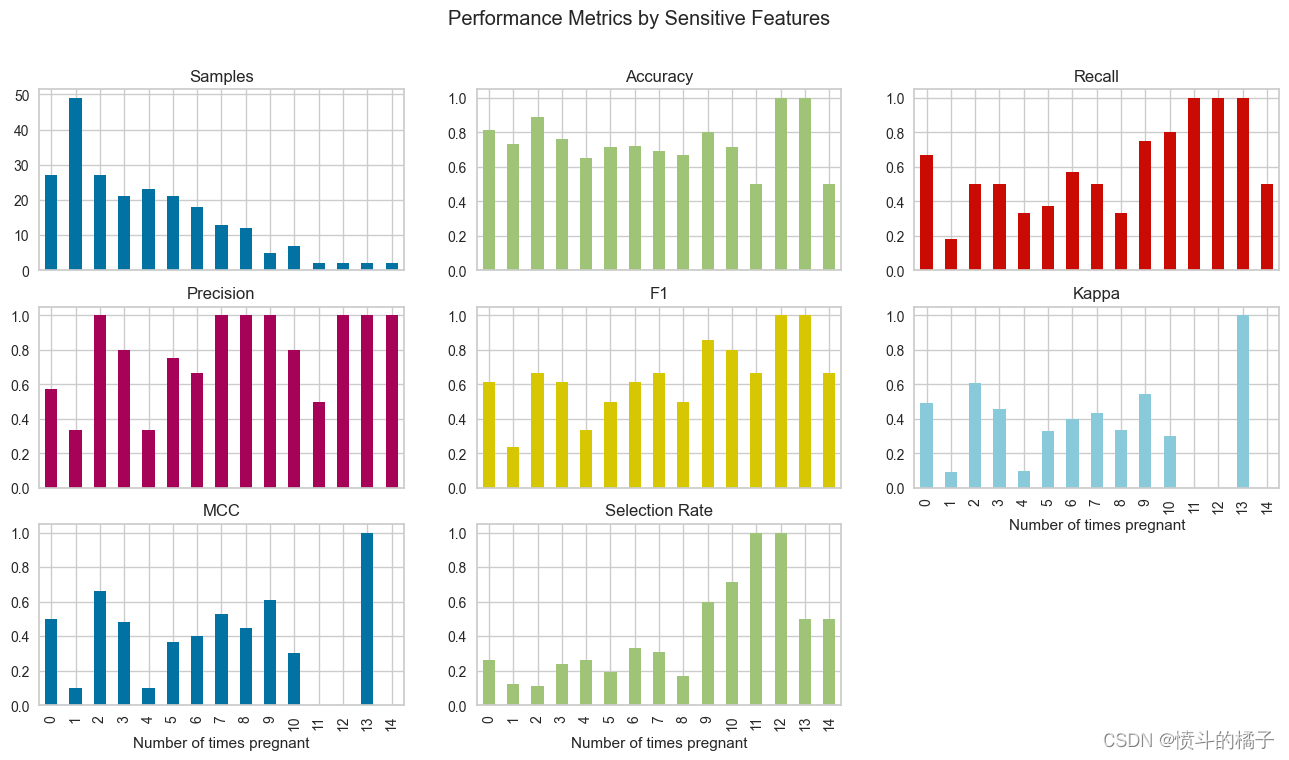
? 仪表盘
仪表盘功能用于为训练模型生成交互式仪表盘。该仪表盘是使用ExplainerDashboard实现的。更多信息请查看Explainer Dashboard.
# 定义一个名为dashboard的函数
# 参数dt:表示数据表格
# 参数display_format:表示显示格式,默认为'inline',即内联显示
# 函数功能:用于创建一个仪表盘,用于展示数据表格dt的内容
dashboard(dt, display_format ='inline')
Note: model_output=='probability', so assuming that raw shap output of DecisionTreeClassifier is in probability space...
Generating self.shap_explainer = shap.TreeExplainer(model)
Building ExplainerDashboard..
The explainer object has no decision_trees property. so setting decision_trees=False...
Warning: calculating shap interaction values can be slow! Pass shap_interaction=False to remove interactions tab.
Generating layout...
Calculating shap values...
Calculating prediction probabilities...
Calculating metrics...
Calculating confusion matrices...
Calculating classification_dfs...
Calculating roc auc curves...
Calculating pr auc curves...
Calculating liftcurve_dfs...
Calculating shap interaction values... (this may take a while)
Reminder: TreeShap computational complexity is O(TLD^2), where T is the number of trees, L is the maximum number of leaves in any tree and D the maximal depth of any tree. So reducing these will speed up the calculation.
Calculating dependencies...
Calculating permutation importances (if slow, try setting n_jobs parameter)...
Calculating predictions...
Calculating pred_percentiles...
Reminder: you can store the explainer (including calculated dependencies) with explainer.dump('explainer.joblib') and reload with e.g. ClassifierExplainer.from_file('explainer.joblib')
Registering callbacks...
Starting ExplainerDashboard inline (terminate it with ExplainerDashboard.terminate(8050))
?创建应用程序
此函数创建一个用于推理的基本 gradio 应用程序。
# 创建一个Gradio应用程序
# 参数:
# - best: 一个变量,表示最佳模型
create_app(best) # 调用create_app函数,并传入best作为参数,创建一个Gradio应用程序
Running on local URL: http://127.0.0.1:7860
To create a public link, set `share=True` in `launch()`.
? 创建API
该函数接受一个输入模型,并创建一个用于推理的POST API。
# 创建API
# 参数:
# - best: 最佳模型
# - api_name: API的名称,默认为'my_first_api'
create_api(best, api_name='my_first_api')
API successfully created. This function only creates a POST API, it doesn't run it automatically. To run your API, please run this command --> !python my_first_api.py
# !python my_first_api.py
# %load my_first_api.py
? 创建Docker
此函数用于创建Dockerfile和requirements.txt,以便将API端点投入生产。
# 定义一个函数create_docker,用于创建一个名为'my_first_api'的Docker容器
create_docker('my_first_api')
Writing requirements.txt
Writing Dockerfile
Dockerfile and requirements.txt successfully created.
To build image you have to run --> !docker image build -f "Dockerfile" -t IMAGE_NAME:IMAGE_TAG .
# 检查使用这个神奇命令创建的DockerFile文件
# %load DockerFile
# 检查使用魔法命令创建的requirements.txt文件
# %load requirements.txt
? 完善模型
该函数在整个数据集上训练给定的模型,包括留出集。
# 将模型进行最终的优化
final_best = finalize_model(best)
final_best
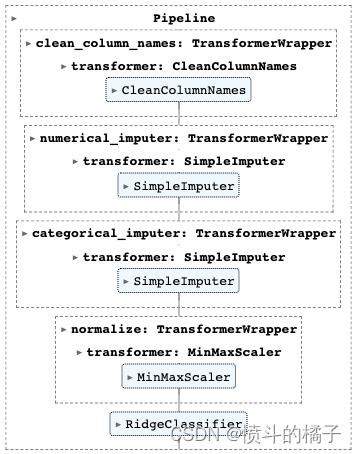
? 转换模型
该函数将训练好的机器学习模型的决策函数转换为不同的编程语言,如Python、C、Java、Go、C#等。如果您想要将模型部署到无法安装正常的Python环境来支持模型推理的环境中,这将非常有用。
# 将学习到的函数转换为Java代码
# 调用convert_model函数,将学习到的函数转换为Java代码,并指定目标语言为Java
# best是学习到的函数
# language参数指定目标语言为Java
# 打印转换后的Java代码
print(convert_model(best, language = 'java'))
public class Model {
public static double score(double[] input) {
return -2.4222329408494767 + input[0] * 0.5943492729771869 + input[1] * 2.3273354603187455 + input[2] * -0.41637843900032867 + input[3] * 0.10259178891131746 + input[4] * -0.3134524281639536 + input[5] * 1.4903417391961826 + input[6] * 0.5019685413792472 + input[7] * 0.12389520576261319;
}
}
? 部署模型
此函数在云上部署整个机器学习流程。
AWS: 在AWS S3上部署模型时,必须使用命令行界面配置环境变量。要配置AWS环境变量,请在终端中输入aws configure命令。需要以下信息,可以使用您的Amazon控制台帐户的身份和访问管理(IAM)门户生成:
- AWS访问密钥ID
- AWS秘密密钥访问
- 默认区域名称(可以在AWS控制台的全局设置下看到)
- 默认输出格式(必须留空)
GCP: 要在Google Cloud Platform(‘gcp’)上部署模型,必须使用命令行或GCP控制台创建项目。创建项目后,您必须创建一个服务帐户,并将服务帐户密钥下载为JSON文件,以在本地环境中设置环境变量。了解更多信息:https://cloud.google.com/docs/authentication/production
Azure: 要在Microsoft Azure(‘azure’)上部署模型,必须在本地环境中设置用于连接字符串的环境变量。转到Azure门户上的存储帐户设置以访问所需的连接字符串。
AZURE_STORAGE_CONNECTION_STRING(作为环境变量必需)
了解更多信息:https://docs.microsoft.com/en-us/azure/storage/blobs/storage-quickstart-blobs-python?toc=%2Fpython%2Fazure%2FTOC.json
# 部署模型到AWS S3
# 调用函数来部署模型
deploy_model(best, model_name='my_first_platform_on_aws', platform='aws', authentication={'bucket': 'pycaret-test'})
# 从AWS S3加载模型
# 从AWS S3加载模型的代码被注释掉了,可能是因为没有提供完整的代码或者没有正确的身份验证信息。
# 加载模型
# loaded_from_aws = load_model(model_name='my_first_platform_on_aws', platform='aws',
# authentication={'bucket': 'pycaret-test'})
# loaded_from_aws
? 保存/加载模型
这个函数将转换流水线和训练好的模型对象保存到当前工作目录中,以pickle文件的形式供以后使用。
# 保存模型
# 使用save_model函数将最佳模型保存为'my_first_model'文件
save_model(best, 'my_first_model')
Transformation Pipeline and Model Successfully Saved
(Pipeline(memory=FastMemory(location=C:\Users\owner\AppData\Local\Temp\joblib),
steps=[('clean_column_names',
TransformerWrapper(exclude=None, include=None,
transformer=CleanColumnNames(match='[\\]\\[\\,\\{\\}\\"\\:]+'))),
('numerical_imputer',
TransformerWrapper(exclude=None,
include=['Number of times pregnant',
'Plasma glucose concentration a 2 '
'hours in an oral glu...
verbose='deprecated'))),
('normalize',
TransformerWrapper(exclude=None, include=None,
transformer=MinMaxScaler(clip=False,
copy=True,
feature_range=(0,
1)))),
('trained_model',
RidgeClassifier(alpha=1.0, class_weight=None, copy_X=True,
fit_intercept=True, max_iter=None,
normalize='deprecated', positive=False,
random_state=123, solver='auto', tol=0.001))],
verbose=False),
'my_first_model.pkl')
# 加载模型
loaded_from_disk = load_model('my_first_model')
loaded_from_disk
# 从磁盘中加载模型文件 'my_first_model',并将其赋值给变量 loaded_from_disk
Transformation Pipeline and Model Successfully Loaded
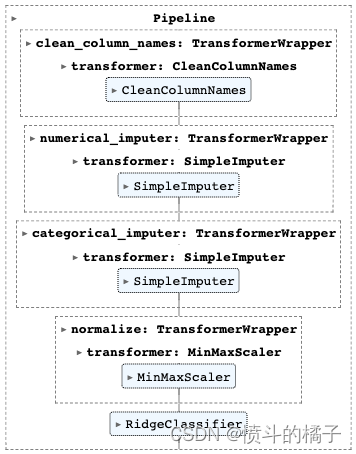
? 保存/加载实验
该函数将实验中的所有变量保存到磁盘上,以便以后恢复而无需重新运行设置函数。
# 保存实验
save_experiment('my_experiment')
# 从磁盘加载实验
exp_from_disk = load_experiment('my_experiment', data=data)
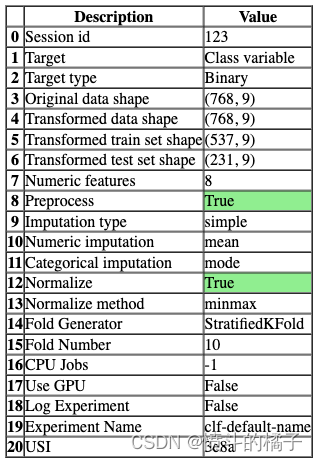
本代码链接
https://download.csdn.net/download/wjjc1017/88646143
本文来自互联网用户投稿,该文观点仅代表作者本人,不代表本站立场。本站仅提供信息存储空间服务,不拥有所有权,不承担相关法律责任。 如若内容造成侵权/违法违规/事实不符,请联系我的编程经验分享网邮箱:veading@qq.com进行投诉反馈,一经查实,立即删除!